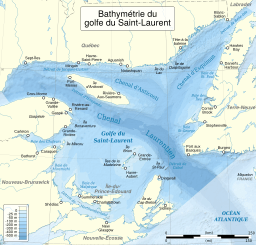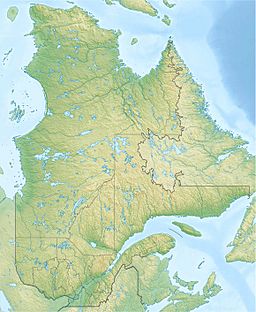Goldthwait Sea facts for kids
Quick facts for kids Goldthwait Sea |
|
|---|---|

Gulf of Saint Lawrence today
|
|
| Location | Gulf of Saint Lawrence and surroundings |
| Coordinates | 48°N 62°W / 48°N 62°W |
| Basin countries | Canada |
The Goldthwait Sea was a huge ancient sea. It formed about 13,000 years ago. This happened during the last Ice Age, when giant ice sheets melted. The sea covered the area where the Gulf of Saint Lawrence is today. It also spread over nearby lands.
Imagine a giant ice sheet, like the Laurentide Ice Sheet. It was super heavy, up to 2 kilometres (1.2 mi) thick! This weight pushed the land down. So, places like Anticosti Island and parts of Quebec and the Maritimes were below sea level. As the ice melted, the land slowly rose back up. This process took about 3,000 years. Even though sea levels were also rising, the Goldthwait Sea slowly shrank. It eventually became much like the Gulf of Saint Lawrence we know today.
Contents
What's in a Name? The Goldthwait Sea
The name "Goldthwait Sea" was suggested in 1969. It helps us tell this ancient sea apart from others, like the Champlain Sea. The sea is named after a smart geologist. His name was James Walter Goldthwait (1880–1947).
Goldthwait did amazing work in eastern Canada. He studied the land in Quebec especially. He made great observations even without modern tools. He didn't have aerial photos or detailed maps. But his ideas were still very good!
How the Goldthwait Sea Formed
The Goldthwait Sea was part of a big change. This change happened in eastern Canada. It was near the end of the Last Glacial Period. The air near the oceans was getting warmer. The southern parts of the ice sheet also warmed up. This caused the huge Laurentide Ice Sheet to melt. It melted from east to west and from south to north.
About 12,000 years ago, sea water could flow into the Saint Lawrence Valley. The Goldthwait Sea quickly spread west. This led to another sea, the Champlain Sea, forming later. Three main things affected the size of the Goldthwait Sea:
- The melting and shrinking of the ice sheet.
- The land rising up after the ice was gone (called isostatic rebound).
- The overall sea level rising around the world.
The last parts of the Laurentide Ice Sheet melted away. This happened in eastern North America between 12,000 and 10,000 years ago. When the ice was gone, the land started to rise. This made the shores of the ancient seas move back. This rising of the land is called post-glacial rebound. It is still happening today!
At first, the land rose very fast. About 9,000 years ago, 85% of the coastal area had risen. It was no longer under water. Around 13,000 years ago, the land rose about 3 centimetres (1.2 in) each year. Today, it still rises, but much slower. It's only about 1 millimetre (0.039 in) per year now.
Lots of fresh water flowed into the North Atlantic Ocean. This included melted ice and rain. This happened as the glaciers melted. For example, water from glacial Lake St Lawrence flowed out around 11,000 years ago. Water from glacial Lake Agassiz flowed out later. This was between 10,900 and 9,900 years ago. More warming caused water to flow from Lake Agassiz and Lake Barlow-Ojibway. This happened between 9,500 and 8,000 years ago. This fresh water seemed to flow into the ocean. It didn't mix much with the salty water deep in the Goldthwait Sea.
Timeline of the Goldthwait Sea
The Goldthwait Sea started forming about 14,000 years ago. This was when the ice sheet first pulled back from the Gulf of Saint Lawrence. At that time, the global sea level was about 55 metres (180 ft) lower than it is today. The sea could cover the coastal areas. This was because the land had sunk under the heavy ice sheet.
After this, sea levels slowly rose. Water from the melting ice returned to the ocean. But at the same time, the land was rising too. This created a complicated pattern of land being covered and uncovered by the sea.
There were two main stages:
- A short stage when the sea quickly moved in. This happened as soon as the ice sheet moved back from the coast.
- A much longer stage when the sea slowly pulled back. This was because the land was rising. This rising is still not completely finished today.
A scientist named Dionne suggested three main periods for the Goldthwait Sea:
- Lower Goldthwaitian: 13,500 to 12,000 years ago.
- Middle Goldthwaitian: 12,000 to 9,000 years ago.
- Upper Goldthwaitian: 9,000 years ago until now.
It's a bit tricky because the ice didn't melt everywhere at the same time. So, the sea reached the south and east areas first. Then it reached the west and north. To make it easier, Dionne called these stages Goldthwaitian I, II, and III.
In the first stage (500 to 1,500 years), the sea followed the melting glacier. The water was cold. It wasn't very salty. The sea was often covered with ice. Some valleys might have been blocked by ice. The land also started to rise during this time.
In the second stage (2,000 to 3,000 years), the sea first spread out, then started to pull back. The land was rising very fast. But sea levels were also going up. Lots of sand and mud built up along the shore. Rivers flowing from the melting ice created deltas. These were at the mouths of rivers on the north shore. The water was still cold, but warmer and saltier than before.
The third stage (from 9,000 or 8,000 years ago until now) was when the sea slowly retreated. The land was still rising, but much slower. Sea levels were also rising slowly. Around 5,500 years ago, the last of the ice sheet disappeared from Quebec. During this stage, streams cut channels through the sand and mud that had been laid down earlier.
How Big Was the Goldthwait Sea?
The Goldthwait Sea started to form in the Saint Lawrence Estuary and Gulf. This was about 13,500 years ago. By 9,300 years ago, the ice had moved back about 8 kilometres (5.0 mi) from the current shoreline. This was in the north coast area. You can see evidence of this in a line of old moraines (piles of rock left by glaciers).
The area that is now the coastal plain was once covered by the Goldthwait Sea. Over the next 400 years, the ice completely left the area. The sea grew to its biggest size. Its coast was parallel to the current coast. But it was about 15 kilometres (9.3 mi) further inland. Some long, narrow bays called fjords reached even further inland. Some went 70 kilometres (43 mi) from the present coast.
The sea covered about 25,000 square kilometres (9,700 sq mi) of what is now Quebec. This included Anticosti Island. It also covered the south of the Saint Lawrence, between Lévis and Baie-Saint-Paul. On the north shore, it covered the area between Les Escoumins and Blanc-Sablon.
You can still see old shorelines at different heights in this area. These show where the sea used to be. The highest point the Goldthwait Sea reached varies. It was about 100 metres (330 ft) above today's sea level at Godbout, Quebec. But it was 130 metres (430 ft) at Sept-Îles, further northeast. This difference happened for a few reasons. The ice cap melted earlier in the south. So, the land there had more time to rise before sea levels went up. Also, the ice sheet was probably thicker further north. This would have pushed the land down more.
What the Sediments Tell Us
The bottom of the Goldthwait Sea had different layers of material. Near the edges, there were rough sands and fine silty clays. Further down, there were thick layers of light gray, fine clays. As the land rose, these sediments were exposed. You can see them along the Saint Lawrence river and estuary today.
The bottom of the Upper Saint Lawrence Estuary has glacial till (rock and dirt left by glaciers). It also has bedrock. On top of this, there are over 200 metres (660 ft) of bluish-gray marine clays. These clays are from the Goldthwait Sea period.
Along the Quebec coast, you can see three main types of sediment:
- Silt and clay: These settled in deep water. River currents didn't affect them much.
- Deltaic sands: These were deposited where currents carried sediment into the sea. They formed deltas at river mouths.
- Coastal sand: As the sea pulled back, a layer of sand covered the other types of sediment.
You can also find tidal flat clays. These are in some calm, shallow areas where the sea used to be.


